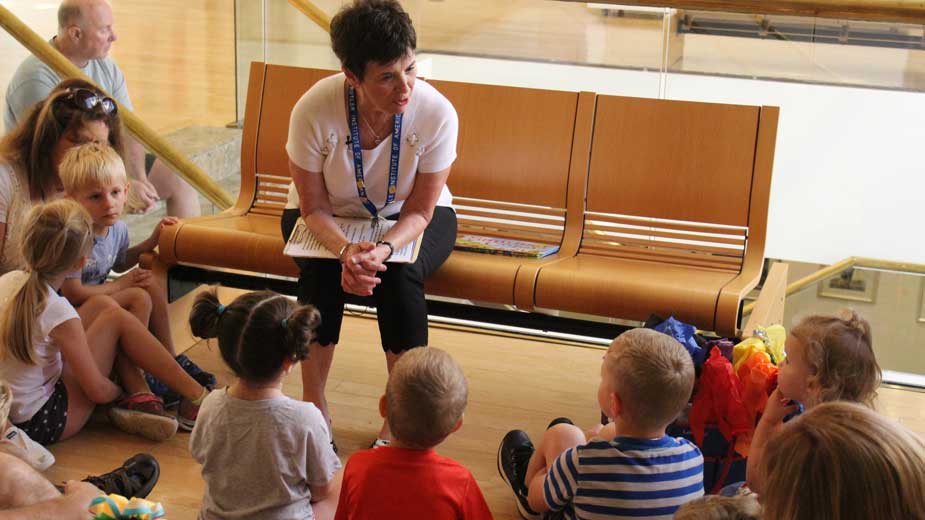Learning Is Lifelong at The Butler Institute of Art
YOUNGSTOWN, Ohio — As she hands out wooden sticks, each decorated in an array of colors, Audrea Neri has just two rules for the children in the Young Friends Adventure program at The Butler Institute of American Art.
First, the docent says, don’t talk while she’s reading – this day, it’s “Summer Color!” by Dianna Murray – and, second, when the color of your stick is read, cheer and shake your stick.
After all the colors have been announced and cheered for, the 35 or so kids move across the lobby to a painting by Janet Fish, “Colors of Summer.” There, Neri has made a puzzle piece out of each element of the painting – flowers, a girl on the beach, a piece of watermelon and so on – and asks the kids to recreate the painting.
The rules aren’t followed perfectly every time, but the program has nonetheless accomplished its goal, Neri says: teaching children about art.
“You look at the painting and you want to teach basic art concepts,” says the retired kindergarten teacher. “You can teach any kind of a concept to a child, no matter how old they are, if you approach it from the right way.”
As a teacher, whether as a docent at the museum or in the classroom, Neri says arts education is a crucial piece of molding young minds.
“We need to create problem-solvers in this new world that we’re living in,” she says. “And where’s that going to come from? The right side of the brain. You need to develop that creative process.”

The program is just one of many education initiatives at The Butler that reaches learners of all ages, from infants and toddlers in strollers to seniors.
The museum has long had a role to play in arts education – former curator Clyde Singer would host art classes for Youngstown State University students in the building – but it’s only been in the past 20 years that programming has expanded to encompass everyone who might visit The Butler.
The impetus for the expansion, says director Louis Zona, was a meeting for the Ohio Museum Association to be hosted by The Butler. As he recalls, many in attendance weren’t particularly thrilled with the idea of traveling to Youngstown. So, Zona called J.J. Cafaro and asked him to help schedule a featured speaker for the conference.
“He asked, ‘Do you want a Kennedy or a Rockefeller?’ ” says Zona, who eventually chose to bring in Ted Kennedy.
“We filled the place with every museum director in the state of Ohio. They all came here to hear Ted Kennedy talk about these very special arts,” Zona says. “We spoke briefly and he said, ‘I want to invite you to a meeting in Washington of arts professionals to see how we can do more to help the arts.’ ”
After that meeting, Zona launched a program initially aimed at exposing children with physical disabilities to art, but the focus was soon broadened to be available to all.
“Not everybody’s going to be an artist. But there’s the idea of appreciating art and getting a sense of what the visual arts culture is all about,” he says.
Then, in 2015, the museum hired Joyce Mistovich as education director, a hiring that Zona calls “a major step” for The Butler.
Among the programs in which she played a key role launching were Stroller Art, Young Friends Adventure and Senior Art and Learn. She joined the museum after retiring from Boardman Local Schools, where she spent 30 years as an art teacher.

“I brought my students to The Butler. Every nine weeks. I’ve been passionate about The Butler since I was young,” she says. “My parents would bring my sisters and me here. My husband is an artist and he’s exhibited here. I’ve felt like The Butler is another home.”
The first program she started was Stroller Art, inviting parents to bring their young children and walk the halls of The Butler. Based on a program created at The Guggenheim Museum in New York, it’s been one of the most successful at The Butler.
While infants don’t necessarily engage in examining and critiquing works by Andy Warhol or Norman Rockwell, they still can learn from seeing their pieces.
Parents in the Stroller Art program are given blocks with colors and are encouraged to talk to their children about what they see in the paintings.
“You’re talking to them and explaining: ‘I’m taking this color. I’m putting it here. I’m moving this shape.’ It’s part of the learning process,” she says. “The brain grows dramatically until 5 years old. The more you can stuff their brain until that age, the greater sense of intelligence down the road and the greater the appreciation that child will have for the arts as they grow.”
Beyond the programs The Butler hosts, Mistovich and the docents are spreading the word outside the walls of the museum. Through the Good Neighbor program, educators in the Mahoning Valley welcome Butler staff into their classrooms to discuss works of art. Students then visit the museum to see it in person. Good Neighbor started with Youngstown City Schools, but has since expanded to include Warren City Schools, Poland Union Elementary and Mathews High School in Vienna Township.
The Butler also welcomes students from area schools taking part in the Art in the Early Morning program, which gets students in before the museum officially opens so they can tour the entire building for field trips.
“We realized that public schools start their days very early and end their days early. The museum opens at 11 o’clock, so it really handicapped schools that wanted to come here,” Zona says. About 30,000 students visited The Butler Institute last year as part of that program, he notes.
Also available is the Sweeney Children’s Gallery, which offers kids hands-on experiences with art. Programming often connects to other showings at The Butler, such as when it hosted an exhibition of the works of Maurice Sendak, author and illustrator of “Where the Wild Things Are.”
The gallery was created in 1987 by the late Robert Sweeney – then owner of the Sweeney dealerships in Boardman and a longtime board member of the museum – in honor of his parents, Arthur and Carolyn.
“As children, we used to go there with our parents and we soon began to realize what a phenomenal opportunity it was to have such a great institution in our town,” recalls Doug Sweeney, Robert’s son and president of Sweeney Chevrolet Buick GMC.
“It was always all about children. Many days, you can see school buses there, maybe more than people realize. Not only do they tour the entire facility and get a glimpse of how fabulous it is, but they spend time in that gallery and have the opportunity to create and learn about art,” Sweeney says.
For adults, educational programming at The Butler is just as varied. The Senior Art & Learn program, for example, offers participants the chance to engage in “slow looking” and take in art at their own paces while learning about the artist and his work. The weekly Film on Art shows movies chronicling the life and times of global artists and art movements, from Gustav Klimt to a two-part series on women in art.
And in celebration of the museum centennial, leaders in the world of American art – curators, museum directors and other experts – are speaking at the The Butler for the “On America” lecture series.
“Being culturally savvy, for me at least, is reflective of someone’s intelligence and the more we can bring in speakers from other museums and walks of life, the greater we serve this area,” says Mistovich, adding that work is underweay to bring art to Alzheimer’s patients living in assisted living centers.
Mistovich admits that when educational programs at The Butler were first launched, she wasn’t sure of what the reaction would be. In fact, she says, the first Young Friends Adventure had no one show up. But in the time since, as word has spread among young and old alike, the education department has become an important facet of the museum.
“The education department is what keeps this museum hopping. We’ve grown tremendously in reaching out to students and adults in our community,” Mistovich says. “What I’m trying to do is integrate all those content areas and the substance of art within all that to show how important it is.”
More Butler 100th coverage
- Honoring 100 Years of The Butler (video)
- 3 Minutes With Dr. Louis Zona, Executive Director, Butler Institute of American Art (video)
- Framing History Is Butler’s Art
- Conservation and Archiving Saves Butler’s Treasures
- Business at The Butler Is Its Own Art
- The Butler Paints a Paper Trail to Display Exhibits
Copyright 2024 The Business Journal, Youngstown, Ohio.


